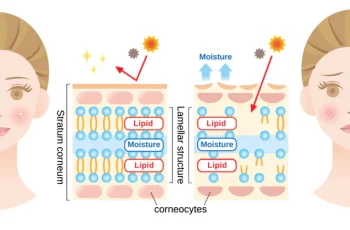A Dermal Therapist Describes The Moisturising Mistakes You Might Be Making
“Just use a moisturiser” honestly, it seems like a pretty simple task but have you ever just tried to shop for a moisturiser? (It can feel as overwhelming as when you’re forced to pick a new nail colour at the nail salon.) Not to mention how annoyed your skin can get when you settle for the wrong one.
The moisturiser that you choose and use on your skin matters. Plus, it’s not really a skincare product in your routine you can just kick to the curb. Skin loves to be hydrated and a good moisturiser can and will help you put moisture into the skin, as well as prevent it from evaporating.
And yes, even if you do have an oilier skin type, you still need to be using a moisturiser, all skins need a moisturiser. You just need to find one designed to help tackle your concerns. Which, as a Dermal Therapist, kind of feels easier said than done. Let me share a few key things to consider when shopping for the right moisturiser.
Firstly though, the actual word ‘moisturiser’ can be used to describe a few different consistencies including: gels, creams and even occlusive ointments, however, the emollient properties in each of these products is what works to keep your skin soft and smooth.
If you have a drier or more sensitive skin you might want to go for an occlusive ointment, while creams (which may have a higher oil content) are great for most skins, and lighter gels (which are usually water based) are better for skins that tend to produce more oil, or are acne/congestion prone.
And if that isn’t confusing enough, you can also switch up the types of moisturisers you want to be using both morning and night depending on personal preference. But there is no need for everyone to do this. Only if it is something you like to do, and it aligns with your budget and lifestyle.
I do want to mention here that unless your “night cream” contains an active ingredient like vitamin a, it is important to note that the term “night cream” is mostly used as a marketing ploy and carries no real meaning, except that perhaps these creams tend to use a higher concentration of ingredients that might provide a bigger boost of moisture before bed.
So, what do we need to look for in a moisturiser?
Drier skins: can go for heavier moisturising creams with ingredients such as glycerin and hyaluronic acid to help attract water to the skin alongside occlusive ingredients that might include lanolin or petrolatum to help lock in moisture.
Oilier skins: might prefer a more water based gel, with ingredients like clover flower extract that can help balance oil production. Even gentle alpha-hydroxy acids may also be beneficial for these skins.
All skins can benefit from additional age management ingredients such as antioxidants and/or ceramides and even calming ingredients such as green tea and/or niacinamide and licorice root.
And sensitive skins should try to steer clear of fragrances.
Ps. moisturisers with SPF 30+ or above are great for the morning (and those that are time poor too).
But what about common moisturising mistakes?
If you feel like you’ve got the right moisturiser but you are either a) still breaking out or b) it feels like it’s not working, there could be a few different reasons why:
You might be over-moisturising with the wrong product and/or layering too many things together. This can lead to blackheads, clogged pores, bumpy skin and even an over-production of oil. This is most commonly an issue for oilier skins, as excess moisture can result in excess sebum. (Cleansing and removing your makeup properly, as well as exfoliating correctly is an important piece of the puzzle here. Your skin can only absorb so much!)
If you’re getting milia from your moisturiser then that is a sign that your moisturiser is too heavy for your skin and you need to swap to something lighter. (You shouldn’t try to ‘pop’ these spots either, they will go away on their own. And if they don’t, it’s best to get them extracted in a clinic.)
Your other skincare products may not be performing. You may be overusing harsh active ingredients, and therefore dealing with a damaged skin barrier. Perhaps you’re layering products incorrectly, or even over/under exfoliating which means your skincare can’t sink in nicely and do what it wants to do.
Hydrating with humectants only, or hydrating with occlusives only. Most skins need both.
Though, we can’t always blame our products. There are lifestyle and dietary factors that come into play when we talk about skin hydration and moisturisation, so it’s always best to seek advice from an expert before overhauling your product lineup and routine.
DQH Can I use salicylic acid first and then vitamin C?
It’s easy to create a skincare routine, but knowing how to use it is another thing entirely. In most cases, if you’re not getting the desired skin results, it could be due to the layering of conflicting ingredients. So, is it possible that salicylic acid and vitamin C are such ingredients? Or are these active ingredients the duo that’s been missing from your skincare routine? If you want answers, stick around because today we are going to explain the benefits of salicylic acid and vitamin C and how they can be used in your daily life.
What are the benefits of salicylic acid for skin?
Salicylic acid is one of the most commonly used beta hydroxy acids and is favored by many people with oily, acne-prone skin. This acid is derived from willow bark, and unlike its water-soluble relatives (called alpha-hydroxy acids), salicylic acid is oil-soluble, which means it can penetrate deeper into the lower layers of the skin. Once it reaches the lower layers, it can help unclog pores of excess sebum, dirt, bacteria, debris, and impurities. This results in clearer skin tones and greater definition.
Not only does salicylic acid benefit the underlying layers, but the outer surface of the skin benefits as well. When applied to the skin, salicylic acid removes the buildup of dead skin cells. This is accomplished by breaking the bonds that hold dead cells to the surface. Over time, this can cause the complexion to look dull and prone to acne, blackheads, and other blemishes.
If you’d like to learn more about salicylic acid and how it can improve your skin, check out this dedicated blog post from a beauty insider.
What are the benefits of vitamin C for skin?
Vitamin C is considered one of the most powerful antioxidants, which means it is very effective at fighting free radicals and preventing them from causing further skin damage. Examples of free radicals include pollution, central heating, UV rays and harsh climate. They attack proteins, fats and cell membranes as soon as they come into contact with the skin, causing signs of premature aging such as fine lines and wrinkles as well as hyperpigmentation, flaky patches of skin and loss of elasticity.
Many people usually prefer to use vitamin C in their morning routine as this ingredient gives the complexion a radiant glow. You’ll also find that vitamin C can target areas of hyperpigmentation, plumping the skin and reducing the appearance of fine lines and wrinkles.
The thing about vitamin C is that there are a lot of outdated studies going back to the 1950s that describe vitamin C as an unstable skin component. Thanks to improvements in modern technology, this is no longer the case as all products now contain a stable form of vitamin C.
Visit The Beauty Insider to learn more about vitamin C. So please check out our blog post.
Can I use salicylic acid first and then vitamin C?
Yes, you absolutely can. In fact, it’s thought that using salicylic acid before using vitamin C ensures it penetrates faster and works faster.
This is an efficient way to utilize two power sources, and the reason has to do with pH. For example, the skin’s natural pH is about 4.7, making it slightly acidic. Salicylic acid and vitamin C are also both acidic, and you’ll find that vitamin C is absorbed quickly into the skin. Therefore, using salicylic acid beforehand can increase the acidity of the skin and allow vitamin C to penetrate into the skin faster.
While this is considered an effective way to combine two powerful ingredients, you need to be aware of your skin type and how it reacts to certain active ingredients. Even people with perfect, normal skin can experience skin sensitivity and irritation. Therefore, always consult a doctor or dermatologist before using any new products on your skin.
It’s also important to follow skin application rules. In this case, you need to use the product correctly to ensure you get the best results for your skin. If you’re not sure what I mean, the basic rule for skin is to start with the thinnest consistency and work your way up to the thickest consistency. This prevents a barrier from forming on the surface, preventing other active ingredients from penetrating the skin.
Can I use salicylic acid at night and vitamin C in the morning?
Yes, absolutely, this is considered the most effective way to get returns without any adverse side effects. This is because there is enough time between applications to ensure that the skin’s pH levels return to balance.
You’ll also find that Vitamin C is rich in antioxidants and is perfect for use in the morning to ensure your skin is protected and looking its healthiest. Due to the small size of salicylic acid molecules, it is an acid that is able to reach the deepest parts of the skin. While this is effective at keeping skin clear, it also increases the risk of irritation and photosensitivity. Therefore, many people prefer to use powerful BHAs in their evening routine without exposure to UV rays, pollution, or harsh weather.
Warning: If you avoid using sunscreen every day, none of these ingredients will do what your skin needs. The combination of chemical peels and powerful ingredients increases the risk of further damage to the skin’s surface. Use SPF 50 every day to keep your skin protected and your lipid barrier healthy, even on cloudy days, keeping your skin in top condition.



